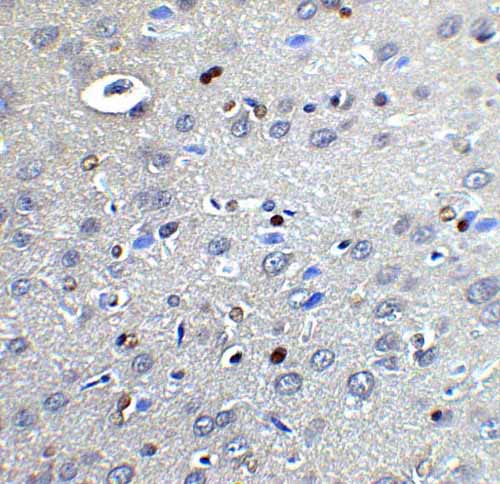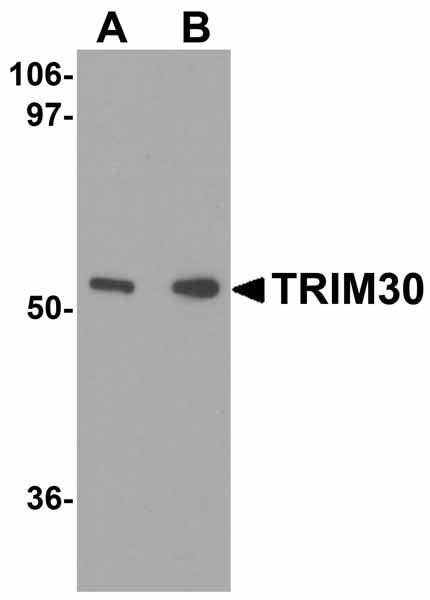MAGEA4 Antibody
- SPECIFICATION
- CITATIONS
- PROTOCOLS
- BACKGROUND

Application
| WB, IHC-P, IF, E |
|---|---|
| Primary Accession | P43358 |
| Other Accession | NP_001011550, 4103 |
| Reactivity | Human, Mouse, Rat |
| Host | Rabbit |
| Clonality | Polyclonal |
| Isotype | IgG |
| Calculated MW | Predicted: 35 kDa; Observed: 45 kDa |
| Application Notes | MAGEA4 antibody can be used for detection of MAGEA4 by Western blot at 1 - 2 μg/mL. Antibody can also be used for immunohistochemistry starting at 5 μg/mL. For immunofluorescence start at 20 μg/mL. |
| Gene ID | 4103 |
|---|---|
| Target/Specificity | MAGEA4 antibody was raised against a 16 amino acid peptide near the amino terminus of human MAGEA4. The immunogen is located within the first 50 amino acids of MAGEA4. |
| Reconstitution & Storage | MAGEA4 antibody can be stored at 4℃ for three months and -20℃, stable for up to one year. |
| Precautions | MAGEA4 Antibody is for research use only and not for use in diagnostic or therapeutic procedures. |
| Name | MAGEA4 |
|---|---|
| Synonyms | MAGE4 |
| Function | Regulates cell proliferation through the inhibition of cell cycle arrest at the G1 phase (PubMed:22842486). Also negatively regulates p53-mediated apoptosis (PubMed:22842486). |
| Tissue Location | Expressed in many tumors of several types, such as melanoma, head and neck squamous cell carcinoma, lung carcinoma and breast carcinoma, but not in normal tissues except for testes and placenta |

Thousands of laboratories across the world have published research that depended on the performance of antibodies from Abcepta to advance their research. Check out links to articles that cite our products in major peer-reviewed journals, organized by research category.
info@abcepta.com, and receive a free "I Love Antibodies" mug.
Provided below are standard protocols that you may find useful for product applications.
Background
MAGEA4 is a member of the melanoma-associated antigen family that consists of a number of antigens recognized by cytotoxic T lymphocytes (1). MAGEA4 may serve as a target for antitumoral vaccination and may play a role in embryonal development and tumor transformation or aspects of tumor progression. It is expressed in many tumors of several types, such as melanoma, head and neck squamous cell carcinoma, lung carcinoma and breast carcinoma and have been implicated in some hereditary disorders, such as dyskeratosis congenital (2-4).
References
Bhan S, Negi SS, Shao C, et al. BORIS binding to the promoters of cancer testis antigens, MAGEA2, MAGEA3, and MAGEA4, is associated with their transcriptional activation in lung cancer. Clin. Cancer Res. 2011; 17:4267-76.
Bhan S, Chuang A, Negi SS, et al. MAGEA4 induces growth in normal oral keratinocytes by inhibiting growth arrest and apoptosis. Oncol. Rep. 2012; 28:1498-502.
Saito T, Wada H, Yamasaki M, et al. High expression of MAGE-A4 and MHC class I antigens in tumor cells and induction of MAGE-A4 immune responses are prognostic markers of CHP-MAGE-A4 cancer vaccine. Vaccine, epub. 2014; S0264-410X(14)01217-1.
Zhang QM, He SJ, Shen N, et al. Overexpression of MAGE-D4 in colorectal cancer is a potentially prognostic biomarker and immunotherapy target. Int. J. Clin. Exp. Pathol. 2014; 7:3918-27.
If you have used an Abcepta product and would like to share how it has performed, please click on the "Submit Review" button and provide the requested information. Our staff will examine and post your review and contact you if needed.
If you have any additional inquiries please email technical services at tech@abcepta.com.













 Foundational characteristics of cancer include proliferation, angiogenesis, migration, evasion of apoptosis, and cellular immortality. Find key markers for these cellular processes and antibodies to detect them.
Foundational characteristics of cancer include proliferation, angiogenesis, migration, evasion of apoptosis, and cellular immortality. Find key markers for these cellular processes and antibodies to detect them. The SUMOplot™ Analysis Program predicts and scores sumoylation sites in your protein. SUMOylation is a post-translational modification involved in various cellular processes, such as nuclear-cytosolic transport, transcriptional regulation, apoptosis, protein stability, response to stress, and progression through the cell cycle.
The SUMOplot™ Analysis Program predicts and scores sumoylation sites in your protein. SUMOylation is a post-translational modification involved in various cellular processes, such as nuclear-cytosolic transport, transcriptional regulation, apoptosis, protein stability, response to stress, and progression through the cell cycle. The Autophagy Receptor Motif Plotter predicts and scores autophagy receptor binding sites in your protein. Identifying proteins connected to this pathway is critical to understanding the role of autophagy in physiological as well as pathological processes such as development, differentiation, neurodegenerative diseases, stress, infection, and cancer.
The Autophagy Receptor Motif Plotter predicts and scores autophagy receptor binding sites in your protein. Identifying proteins connected to this pathway is critical to understanding the role of autophagy in physiological as well as pathological processes such as development, differentiation, neurodegenerative diseases, stress, infection, and cancer.



